 The
TheNuclear
Information
Project
 The TheNuclear Information Project |
FAS | Nuke | Guide |||| Index | Search | Join FAS |
The B-2 Spirit is a multi-role bomber capable of delivering both conventional and nuclear munitions.
Along with the B-52 and B-1B, the B-2 provides the penetrating flexibility and effectiveness inherent in manned bombers. Its low-observable, or "stealth," characteristics give it the unique ability to penetrate an enemy's most sophisticated defenses and threaten its most valued, and heavily defended, targets. Its capability to penetrate air defenses and threaten effective retaliation provide an effective deterrent and combat force well into the 21st century.
The blending of low-observable technologies with high aerodynamic efficiency and large payload gives the B-2 important advantages over existing bombers. Its low-observability provides it greater freedom of action at high altitudes, thus increasing its range and a better field of view for the aircraft's sensors. Its unrefueled range is approximately 6,000 nautical miles (9,600 kilometers).
The B-2's low observability is derived from a combination of reduced infrared, acoustic, electromagnetic, visual and radar signatures. These signatures make it difficult for the sophisticated defensive systems to detect, track and engage the B-2. Many aspects of the low-observability process remain classified; however, the B-2's composite materials, special coatings and flying-wing design all contribute to its "stealthiness."
The B-2 has a crew of two pilots, an aircraft commander in the left seat and mission commander in the right, compared to the B-1B's crew of four and the B-52's crew of five.
The B-2 is intended to deliver gravity nuclear and conventional weapons, including precision-guided standoff weapons. An interim, precision-guided bomb capability called Global Positioning System (GPS) Aided Targeting System/GPS Aided Munition (GATS/GAM) is being tested and evaluated. Future configurations are planned for the B-2 to be capable of carrying and delivering the Joint Direct Attack Munition (JDAM) and Joint Air-to-Surface Standoff Missile.B-2s, in a conventional role, staging from Whiteman AFB, MO; Diego Garcia; and Guam can cover the entire world with just one refueling. Six B-2s could execute an operation similar to the 1986 Libya raid but launch from the continental U.S. rather than Europe with a much smaller, more lethal, and more survivable force.

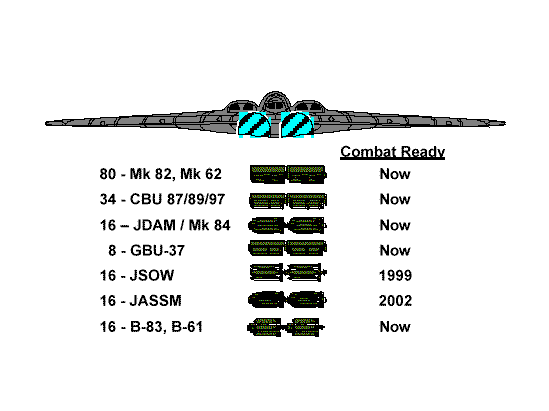
The B-2 development program was initiated in 1981, and the Air Force was granted approval in 1987 to begin procurement of 132 operational B-2 aircraft, principally for strategic bombing missions. With the demise of the Soviet Union, the emphasis of B-2 development was changed to conventional operations and the number was reduced to 20 operational aircraft, plus 1 test aircraft that was not planned to be upgraded to an operational configuration. Production of these aircraft has been concurrent with development and testing.
The first B-2 was publicly displayed on Nov. 22, 1988, when it was rolled out of its hangar at Air Force Plant 42, Palmdale, Calif. Its first flight was July 17, 1989. The B-2 Combined Test Force, Air Force Flight Test Center, Edwards Air Force Base, Calif., is responsible for flight testing the engineering, manufacturing and development aircraft as they are produced. Three of the six developmental aircraft delivered at Edwards are continuing flight testing.
Whiteman AFB, Mo., is the B-2's only operational base. The first aircraft, Spirit of Missouri, was delivered Dec. 17, 1993. Depot maintenance responsibility for the B-2 is performed by Air Force contractor support and is managed at the Oklahoma City Air Logistics Center at Tinker AFB, Okla.
The prime contractor, responsible for overall system design and integration, is Northrop Grumman's Military Aircraft Systems Division. Boeing Military Airplanes Co., Hughes Radar Systems Group and General Electric Aircraft Engine Group are key members of the aircraft contractor team. Another major contractor, responsible for aircrew training devices (weapon system trainer and mission trainer) is Hughes Training Inc. (HTI) - Link Division, formerly known as C.A.E. - Link Flight Simulation Corp. Northrop Grumman and its major subcontractor HTI, are responsible for developing and integrating all aircrew and maintenance training programs.
The Air Force is accepting delivery of production B-2s in three configuration blocks--blocks 10, 20, and 30. Initial delivery will be 6 test aircraft, 10 aircraft in the block 10 configuration, 3 in the block 20 configuration, and 2 in the block 30 configuration.
Block 10 configured aircraft provide limited combat capability with no capability to launch conventional guided weapons. The Block 10 model carries only Mk-84 2,000-pound conventional bombs or gravity nuclear weapons. B-2s in this configuration are located at Whiteman Air Force Base and are used primarily for training. Block 20 configured aircraft have an interim capability to launch nuclear and conventional munitions, including the GAM guided munition. The Block 20 has been tested with the Mk-84, 2,000-pound, general-purpose bombs and the CBU-87/B Combined Effects Munition cluster bombs (low-altitude, full-bay release).All block 10, 20, and test aircraft are to eventually be modified to the objective block 30 configuration. This modification process began in July 1995 and is scheduled to be completed in June 2000.Block 30 configured aircraft are fully capable and meet the essential employment capabilities defined by the Air Force. The first fully configured Block 30 aircraft, AV-20 Spirit of PENNSYLVANIA, was delivered to the Air Force on 07 August 1997. Compared to the Block 20, the Block 30s have almost double the radar modes along with enhanced terrain-following capability and the ability to deliver additional weapons, including the Joint Direct Attack Munition and the Joint Stand Off Weapon. Other features include incorporation of configuration changes needed to make B-2s conform to the approved radar signature; replacement of the aft decks; installation of remaining defensive avionics functions; and installation of a contrail management system.
The B-2 fleet will have 16 combat-coded aircraft by the second quarter of FY00,
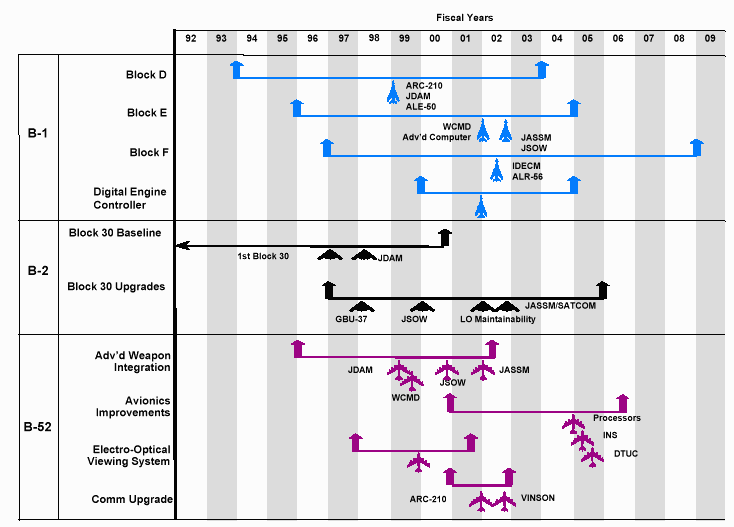
Signature Improvements - The B-2�s signature meets operational
requirements against today�s threats. As advanced threats proliferate, it will be
prudent to investigate advanced
signature reduction concepts and
determine if it is necessary to
improve the B-2�s low observable
signature.
CANDIDATE LONG TERM UPGRADES
BEYOND FY 15
TOTAL
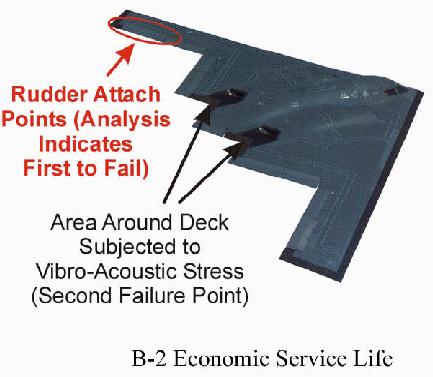 The basis for the useful life of the B-2 includes data from initial Developmental Test and Evaluation analysis. Data indicates the aircraft should be structurally sound to approximately 40,000 flight hours using current mission profiles. Analysis further suggests that the rudder attachment points are the first structural failure item. The B-2 has not implemented an ASIP similar to the other bombers, and this makes it difficult to predict the economic service life and attrition rate. However, a notional projection, based on the B-52, predicts one aircraft will be lost each 10 years. This attrition rate, plus attrition due to service life, will erode the B-2 force below its requirement of 19 aircraft by 2027.
The basis for the useful life of the B-2 includes data from initial Developmental Test and Evaluation analysis. Data indicates the aircraft should be structurally sound to approximately 40,000 flight hours using current mission profiles. Analysis further suggests that the rudder attachment points are the first structural failure item. The B-2 has not implemented an ASIP similar to the other bombers, and this makes it difficult to predict the economic service life and attrition rate. However, a notional projection, based on the B-52, predicts one aircraft will be lost each 10 years. This attrition rate, plus attrition due to service life, will erode the B-2 force below its requirement of 19 aircraft by 2027.
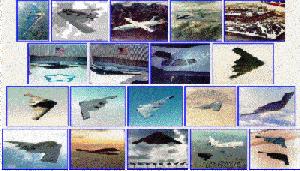
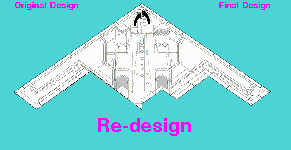
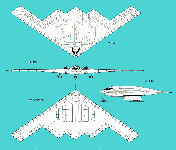
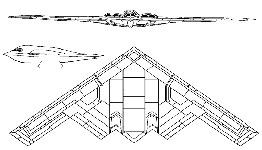
| ||||
| Primary function: | Multi-role heavy bomber. | |||
| Prime Contractor: | Northrop Grumman Corp. | |||
| Contractor Team: | Boeing Military Airplanes Co., General Electric Aircraft Engine Group Hughes Training Inc., Link Division | |||
| Power Plant/Manufacturer: | Four General Electric F-118-GE-100 engines | |||
| Thrust: | 17,300 pounds each engine (7,847 kilograms) | |||
| Length: | 69 feet (20.9 meters) | |||
| Height: | 17 feet (5.1 meters) | |||
| Wingspan: | 172 feet (52.12 meters) | |||
| Speed: | High subsonic | |||
| Ceiling: | 50,000 feet (15,152 meters) | |||
| Takeoff Weight (Typical): | 336,500 pounds (152,635 kilograms) | |||
| Range: | Intercontinental, unrefueled | |||
| Armament: |
| |||
| Payload: | 40,000 pounds (18,000 kilograms) | |||
| Crew: | Two pilots | |||
| Unit cost: | Approximately $2.1 billion [average] | |||
| Year Deployed: | 1994 | |||
| Inventory: | Total: 21; Active force: 16 (planned operational aircraft) | |||
| Air Vehicle |
Aircraft # | Name [*] | Ordered | Delivered to USAF |
Arrived Whiteman |
| AV- 1 | 82-1066 | Fatal Beauty | n/a | 17 Jul 89 | |
| AV- 2 | 82-1067 | Spirit of ARIZONA Ship From Hell [Murphy's Law] |
n/a | 19 Oct 90 | 20 Mar 98 |
| AV- 3 | 82-1068 | Spirit of NEW YORK Navigator / Ghost [Afternoon Delight] |
n/a | 18 Jun 91 | 10 Oct 97 |
| AV- 4 | 82-1069 | Spirit of INDIANA Christine |
n/a | 02 Oct 92 | 22 May 99 |
| AV- 5 | 82-1070 | Spirit of OHIO Fire and Ice [Toad] |
n/a | 05 Oct 92 | 18 Jul 97 |
| AV- 6 TOV&V | 82-1071 | Spirit of MISSISSIPPI Black Widow / Penguin [Arnold the Pig] |
n/a | 02 Feb 93 | 23 May 98 |
| AV- 7 | 88-0328 | Spirit of TEXAS Pirate Ship |
1987 | 29 Aug 94 | 31 Aug 94 |
| AV- 8 | 88-0329 | Spirit of MISSOURI | 1987 | 11 Dec 93 | 17 Dec 93 |
| AV- 9 | 88-0330 | Spirit of CALIFORNIA | 1988 | 16 Aug 94 | 17 Aug 94 |
| AV-10 | 88-0331 | Spirit of S. CAROLINA | 1988 | 29 Dec 94 | 30 Dec 94 |
| AV-11 | 88-0332 | Spirit of WASHINGTON | 1989 | 27 Oct 94 | 30 Oct 94 |
| AV-12 | 89-0127 | Spirit of KANSAS | 1989 | 16 Feb 95 | 17 Feb 95 |
| AV-13 | 89-0128 | Spirit of NEBRASKA | 1990 | 26 Jun 95 | 28 Jun 95 |
| AV-14 | 89-0129 | Spirit of GEORGIA | 1990 | 25 Sep 95 | 14 Nov 95 |
| AV-15 | 90-0040 | Spirit of ALASKA | 1991 | 12 Jan 95 | 24 Jan 96 |
| AV-16 | 90-0041 | Spirit of HAWAII | 1991 | 21 Dec 95 | 10 Jan 96 |
| AV-17 | 92-0700 | Spirit of FLORIDA | 1992 | 29 Mar 96 | 3 Jul 96 |
| AV-18 | 93-1085 | Spirit of OKLAHOMA | 1993 | 13 May 96 | 15 May 96 |
| AV-19 | 93-1086 | Spirit of KITTY HAWK | 1993 | 30 Aug 96 | |
| AV-20 | 93-1087 | Spirit of PENNSYLVANIA | 1993 | 05 Aug 97 | |
| AV-21 | 93-1088 | Spirit of LOUISIANA | 1993 | 10 Nov 97 | |
| AV-22-76 | Cancelled | ||||
| AV-77-133 | Cancelled | ||||
| AV-134-165 | Cancelled | ||||
| AIRCRAFT NAMES Each stealth bomber has at least three designations. The Air Vehicle [AV] number [eg, AV-1], indicative of the aircraft's construction sequence within the stealth bomber program. The tail number [eg 82-1066] is part of the general Air Force numbering system in which the first two digits are the year in which the plane was authorized, and the last four digits are the aircraft's unique serial number. The planes also have both formal and informal names, which is an unusual [though increasingly common] practice. For a long time we had a bit of difficulty providing robust correlation among these three designation systems, since Whiteman AFB and Dave Hastings did't have their stories straight on Spirit of OHIO and Spirit of ARIZONA. While we think that we have finally gotten these ducks lined up, any additional corrections would be vastly appreciated. Following the naval precedent in which battleships, and subsequently whatever ship the Navy regarded as its capital ship [currently ballistic missile submarines, but it was nuclear powered cruisers for a while] were named after states, operational B-2 aircraft are named after states, with the annoying exception of Spirit of KITTY HAWK. States so honored are generally those with a close association [operational, political, or otherwise] with the program. This would seem to place an upper limit of 50 on the number of aircraft that can eventually be expected to be produced, though one imagines that additional states can be admitted to the Union if the need arises. Test aircraft have a somewhat less illustrious, and less definitive, naming system. Sources vary as to the names that have at times been used in connection with these airfraft, and we provide all names that have been reportedly associated with these vehicles [with the less certain names in [] parentheses]. As they enter operational service, these aircraft are given more dignified state names, as recently happened with AV-2 Spirit of OHIO. |
|||||